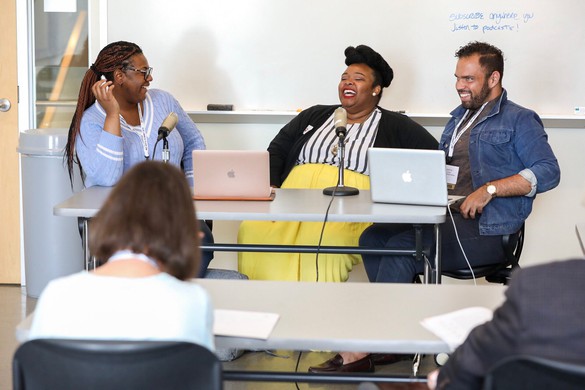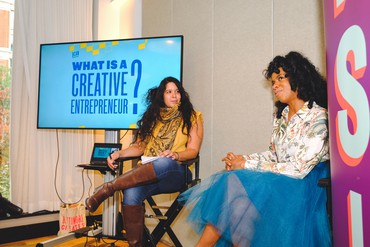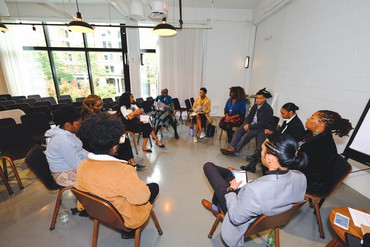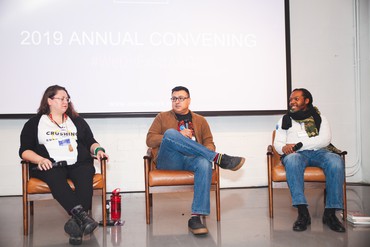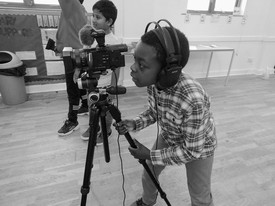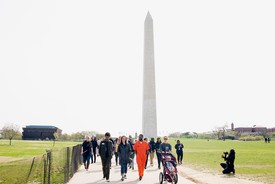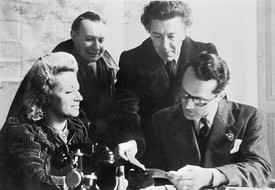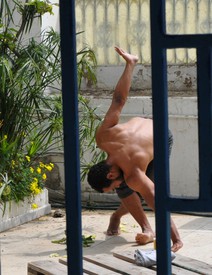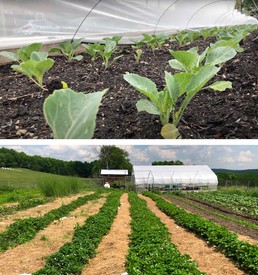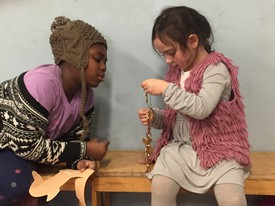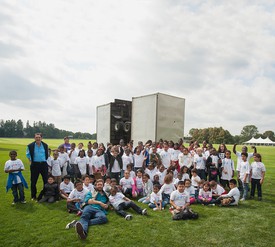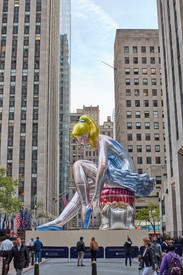
Quanice G. Floyd is the founder and director of the Arts Administrators of Color Network and the executive director of Arts Education in Maryland Schools. She is an advocate for racial equity, social justice, and arts education and hopes to change the world one person at a time for the better.

In service of the communities to which he belongs, Joshua Henry Jenkins focuses his energy on creating and supporting projects that uplift and create community for people of color, LGBTQIA individuals, citizens of rural areas, and most importantly those who exist at the intersections of those identities. He is also a facilitator around issues of equity, inclusion, access, and privilege in organizational workplace culture in the arts.
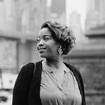
Jess Sims is a freelance writer and content creator. She covers the spectrum of the Black experience, and writes about all things related to living as a fat, Black woman including: diet culture, healthcare disparities, body positivity, Black culture and art. In her spare time, she only wears neutral colors; you can follow her journey on A Neutral Life.
The coronavirus pandemic has swept across the world, devastating millions. The virus’s economic impact has been widespread, impacting tourism, retailers, universities, and yes, the arts. In times of economic panic, arts funding tends to get cut early, and funding for Black visual and performing arts struggles even in the most prosperous times. A 2015 study of dance companies, museums, and theaters in the US found that the top twenty POC arts organizations surveyed had a median budget of $3.8 million—as opposed to $61 million for the top twenty mainstream organizations.
The Arts Administrators of Color Network (AAC), a nonprofit organization based in the Washington, DC area, is working hard to counter the effects of the current crisis by providing much-needed relief to the community. The organization started the Arts Leaders of Color Emergency Fund on March 13, in the earliest days of the pandemic, foreseeing the severe impact that COVID-19 would have on BIPOC artists and arts administrators. As of August 1st, the fund had received over $110,000 in donations and contributions, and has distributed 350 $200 microgrants to US-based BIPOC applicants; but the need is much greater. More than 11,000 people have applied for grants, and the organization has vowed to keep the fund open as long as necessary.
AAC is a small but hopeful and mighty organization. Run completely by volunteers, it was founded in 2016 to help build community and provide a network for BIPOC people working in the arts. AAC holds multiple programs throughout the year to educate arts leaders on how to foster true inclusivity. The organization’s main concern is fighting for equity and representation in the arts—and there is a lot of fighting to be done. Art remains a fairly closed door to many people of color, and representation is low. For example, Black artists have taken note of the disparity of Black art in major museums like the Metropolitan Museum of Art in New York. The museum hosted just eight exhibitions focused on the work of Black artists between 2009 and 2019, out of close to forty exhibitions per year. Whether these disparities are due to lack of exposure, funding, or recognition, we know they are an issue, but change is slow. The opportunities for Black artists still are just not there.
AAC is the brainchild of Quanice G. Floyd, a music educator and PhD student, who has spent ten-plus years in the DC area, working in public schools and advocating for access, diversity, inclusion, and equity in the arts. Floyd sits on AAC’s board of directors, which is entirely composed of BIPOC arts professionals. Board member Joshua Henry Jenkins has been working extensively on the Arts Leaders of Color Emergency Fund, helping manage the fund and grants. Jenkins leads communications efforts for the organization and currently works as the director of web and new media strategies at Americans for the Arts.
JESS SIMSAAC started this fund back in March, which was fairly early in the pandemic. What made you realize the urgent need and say, “Okay, we need to start this right now”?
JOSHUA HENRY JENKINSPeople were trying to figure out what was going on, but it was impossible to ignore the immediate effects across the field. Theaters were shutting down and arts programs were scaling back. Very early on, we were seeing people losing gigs, losing jobs. Folks on our own board were eventually being furloughed. So it was like, “Okay, we know this is happening. What are we going to do about it?” We felt we needed to put our time and energy into supporting our community.
JSWhat was the driving factor in structuring the COVID-19 emergency fund as mini-grants?
Quanice FloydThe driving factor for creating the fund was simple: to support the immediate needs of Black, Indigenous, People of Color artists and arts administrators.
JHJThe idea of microgranting was at the top of our minds and we ran with it. We wanted to make sure that we had some kind of structure for applicants to access quickly and easily. That would allow us to start raising money and then immediately redistribute it back out.
JSYou had over 10,000 applications for the funding through June. Have you started dispersing the microgrants?
JHJYes.
JSHow much money has been raised?
JHJWe have received over $80,000 dollars in donations. And because we’re run by volunteers and we’re doing everything on our own, we distribute funds on a weekly cycle. We have distributed approximately $55,000 through July, which is 275 microgrants.
JSWhat have been some of the greatest needs for the grants?
QFWe’ve seen that folks are needing the grants for paying monthly/regular bills, securing medications, assisting with rent, etcetera. Basically the money is going towards the necessities that everyone needs to survive.
JHJWhen I think about the thousands of people who have applied, I realize that we would require a crazy amount of money to keep up with the need. So on one hand I’m like, it’s a beautiful thing that we’ve raised this much money, but oftentimes I think about the folks we haven’t been able to grant yet and I think, “Oh, we’ve got a long way to go.” That is why I often refer to this fund as an indefinite one. There is no hard stop on this. If we see the need, then we’re going to keep raising money as best as we can.
JSFunding is a fairly persistent issue for BIPOC artists and arts administrators. Do you think COVID-19 shed a light on that? Or is it still kind of status quo: “We know COVID’s an issue. We know it disproportionately impacts Black and Brown artists and arts administrators, but you know, we’re going to continue on as we always have?” What are your thoughts on that?
JHJFor us to be a volunteer-led organization with a couple of years in the game, we haven’t been around for long, we’re not an institution like a lot of these others. And in a national way, we haven’t seen as many funds directed specifically toward BIPOC artists and arts administrators. That’s troubling to me. We’ve certainly seen funds pop up regionally and in cities, or sometimes the funding goes through arts councils in local communities.
What I do look forward to after COVID-19 is creating a new world. A world that is liberatory in its own right, where people understand that their liberation is wrapped up in the liberation of others.
Quanice Floyd
QFIt shouldn't take a catastrophic pandemic to bring light to these issues. People need to wake up and realize this has been happening all along. What I do look forward to after COVID-19 is creating a new world. A world that is liberatory in its own right, where people understand that their liberation is wrapped up in the liberation of others, just as Lilla Watson [Indigenous Murri visual artist, activist, and academic working in the field of women’s issues and Aboriginal epistemology] has so eloquently stated.
JSWhat is the best-case scenario for the fund? If everything would go your way, what would you like to see happen with the fund in the future?
JHJIt’s funny, I think we’ve been so focused on the minute-by-minute, day-by-day operations of the fund that we haven’t had a concrete conversation around what it might look like a year from now. In my brain, obviously, I want everybody who applies to be funded, bare minimum. I know the financial and economic impact of COVID-19 is big and strong and will continue to be. And this is bigger than having a vaccine. Even if we have a vaccine by the top of the year, that won’t solve everything; the financial impact will be felt for a long time. And so sustaining people through that time is going to be top priority. That’s why it feels indefinite, because we don’t know the long-term ramifications this will continue to have on the economy and on the artist community and the arts administration community.
QFThe end result of a nonprofit is to “resolve” an issue that isn't being addressed in the public and private sector. That said, we’re not looking to expand the program; we're hoping to put ourselves out of business. We do this work so that we shouldn’t have to do it in the future. We’re stepping up because other (larger) organizations haven’t.
JHJSomebody told us that we were in Rolling Stone—in the June 2020 print issue we were listed as a fund to contribute to. And I was like, “What does that mean?” I was surprised: “Us? Nobody else is doing this?” Of course I believe in and love the work that we’re doing, but it’s just compelling to realize that with all the funds in existence and all the money out there available in arts funds and foundations, we’re the most visible, the most known.
For the future, I envision an ongoing fund where folks who come upon equally hard times can access a lifeline. One that’s not necessarily pandemic-related, because we know that this is not the only struggle that artists and arts administrators feel. We want to continue to raise money around larger artist and arts administration needs for people of color to make sure that there is support for them going forward.
According to an ongoing survey of US arts organizations conducted by Americans for the Arts, as of mid-July 2020 the estimated economic impact of the coronavirus pandemic totaled $9.1 billion, with 62,359 personnel laid off and 49,559 furloughed. Only 59% of survey respondents were confident that their organizations will survive the impact of covid-19.
